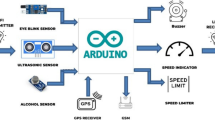Abstract
VANETs (Vehicular Ad-hoc NETworks) were deemed the most suitable communication network for supporting the dissemination of alert messages due to their low dissemination delays as well as extensive vehicle coverage in vicinity of an emergency. With the introduction of cooperative ITS services, it is envisaged that emerging vehicular networks will progressively rely on Vehicle to Infrastructure (V2I) communication lines, which are expected to be nominally accessible with certain temporary as well as time-limited connectivity losses. This study proposes a novel method for VANET-based efficient vehicle clustering and routing based on network infrastructure for high-performance smart transportation. The vehicle clustering is using infrastructure-based fuzzy K-means convolutional neural networks. Then the energy-efficient cluster-based multi-hop distributed routing has been carried out. The experimental analysis in terms of latency, network lifetime, throughput, QoS, energy efficiency, and packet delivery ratio. In addition, empirical equations that can be used to predict speed recommendations for drivers are derived from the result.










Similar content being viewed by others
Data availability
Enquiries about data availability should be directed to the authors.
References
Awan KA, Din IU, Almogren A (2022) A blockchain-assisted trusted clustering mechanism for IoT-enabled smart transportation system. Sustainability 14(22):14889
Dhanaraj RK, Islam SH, Rajasekar V (2022) A cryptographic paradigm to detect and mitigate blackhole attack in VANET environments. Wireless Netw 28(7):3127–3142
Diallo EH, Dib O, Al Agha K (2022) A scalable blockchain-based scheme for traffic-related data sharing in VANETs. Blockchain: Research and Applications, 3(3):100087
Farooqi AM, Alam MA, Hassan SI, Idrees SM (2022) A fog computing model for vanet to reduce latency and delay using 5G network in smart city transportation. Appl Sci 12(4):2083
Feng H, Chen D, Lv Z (2022) Blockchain in digital twins-based vehicle management in VANETs. IEEE Trans Intell Transp Syst 23(10):19613–19623
Hajlaoui R, Alaya B, Mchergui A (2022) Optimized VANET routing protocol using cuckoo search algorithm. In: 2022 International Wireless Communications and Mobile Computing (IWCMC) (pp 824–828) IEEE
Hota L, Nayak BP, Kumar A, Sahoo B, Ali GMN (2022) A performance analysis of VANETs propagation models and routing protocols. Sustainability 14(3):1379
Humayun M, Jhanjhi N, Hamid B, Ahmed G (2020) Emerging smart logistics and transportation using IoT and Blockchain. IEEE Internet Things Mag 3(2):58–62. https://doi.org/10.1109/IOTM.0001.1900097
Jubair MA, Mostafa SA, Zebari DA, Hariz HM, Abdulsattar NF, Hassan MH, Alouane MTH (2022) A QoS aware cluster head selection and hybrid cryptography routing protocol for enhancing efficiency and security of VANETs. IEEE Access 10:124792–124804
Karabulut MA, Shah AS, Ilhan H (2022) A novel MIMO-OFDM based MAC protocol for VANETs. IEEE Trans Intell Transp Syst 23(11):20255–20267
Khalfaoui H, Azmani A, Farchane A, Safi S (2022) Using a fuzzy-Bayesian approach for predicting the QoS in VANET. Appl Compt Syst 27(2):101–109
Khan MU, Hosseinzadeh M, Mosavi A (2022) An intersection-based routing scheme using Q-learning in vehicular Ad Hoc networks for traffic management in the intelligent transportation system. Mathematics 10(20):3731
Maram RK, Ponnapalli VS, Maddiboyina HV (2022) Smart transportation and evolutionary algorithms: an approach to understand vehicular Ad-Hoc network. In: Artificial Intelligence and Data Science: First International Conference, ICAIDS 2021, Hyderabad, India, December 17–18, 2021, Revised Selected Papers (pp 476–489) Cham: Springer Nature Switzerland
Marwah GPK, Jain A, Malik PK, Singh M, Tanwar S, Safirescu CO, Alkhayyat A (2022) An improved machine learning model with hybrid technique in VANET for robust communication. Mathematics 10(21):4030
Poongodi M, Bourouis S, Ahmed AN, Vijayaragavan M, Venkatesan KGS, Alhakami W, Hamdi M (2022) A novel secured multi-access edge computing based VANET with neuro fuzzy systems based blockchain framework. Comput Commun 192:48–56
Ramya Devi M, Jasmine Selvakumari Jeya I, Lokesh S (2023) Adaptive scheduled partitioning technique for reliable emergency message broadcasting in VANET for intelligent transportation systems. Automatika 64(2):341–354
Satyanarayana RK, Selvakumar K (2022) An intelligent transport system in VANET using proxima analysis. International Journal of Advanced Computer Science and Applications 13(7)
Sehrawat P, Chawla M (2022) Interpretation and investigations of topology based routing protocols applied in dynamic system of VANET. Wireless Personal Communications pp 1–27
Sharma SK, Rao RS, Singh P, Khan SA (2022) Evaluation of VANETs routing protocols for data-based smart health monitoring in intelligent transportation systems. Int J Math Eng Manag Sci 7(2):211
Theerthagiri P, Gopala Krishnan C (2022) Vehicular multihop intelligent transportation framework for effective communication in vehicular ad-hoc networks. Concurr Compt Pract Exp 34(10):e6833
Türkoğlu M, Polat H, Koçak C, Polat O (2022) Recognition of DDoS attacks on SD-VANET based on combination of hyperparameter optimization and feature selection. Expert Syst Appl 203:117500
Funding
This research is not supported by any Government or Non-Government organization.
Author information
Authors and Affiliations
Corresponding author
Ethics declarations
Conflict of interest
All authors declare no conflict of Interest.
Ethical approval
This article does not contain any studies with animals performed by any of the authors.
Additional information
Publisher's Note
Springer Nature remains neutral with regard to jurisdictional claims in published maps and institutional affiliations.
Rights and permissions
Springer Nature or its licensor (e.g. a society or other partner) holds exclusive rights to this article under a publishing agreement with the author(s) or other rightsholder(s); author self-archiving of the accepted manuscript version of this article is solely governed by the terms of such publishing agreement and applicable law.
About this article
Cite this article
Xia, X., Li, X., Hou, W. et al. AI-based efficient wireless technologies and infrastructure-based networks with VANET for smart transportation high performance. Soft Comput (2023). https://doi.org/10.1007/s00500-023-08340-4
Accepted:
Published:
DOI: https://doi.org/10.1007/s00500-023-08340-4




